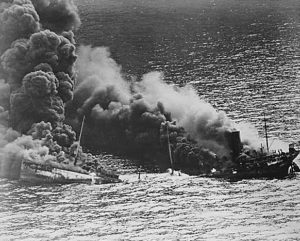One of the Coast Guard’s 83 feet prepared as cazasubmarinos testing of navigation, this in particular has the Rails for empty depth charges and 20 mm in the aft part, the delivered to Cuba had her bow.
German submarines had sunk several Cuban merchant ships, with a sequel of more than 70 marine dead.
This story begins when in 1941 are sent to state together 7 young to study the specialty in sonar devices (sound), to detect and hunt submarines; at that time there was no radar.
On May 15, 1943, our submarine hunt was guarding a convoy that came with goods toward Havana. It was near Nuevitas. A Cuban fighter plane detected a submarine and told the submarine hunting. The captain of the CS.13, Mario Ramirez Delgado, hoisted the flag of combat and placed his boat up the place where the plane indicated that the underwater enemy was.
The captain ordered to shed two of eight bombs with which the cazasubmarinos was fitted. Thus began the battle. She felt an explosion that shook our boat. While a thick oil macha is sighted in the sea.
Ensures that during the Second world war in Latin America only two German submarines sank: one in Brazil and the other in Cuba. At the end of the war the manning of the CS-13 was awarded. A curious fact, I tell them that in the staffing of that historic ship was the young Norberto Collado Abreu, who was the helmsman of the ship that brought the crew of the yacht Granma to Cuba.
Agencies / Ra. Encyclopedia/Juan B. Rodriguez/Internet Photos/Arnoldo Varona/TheCubanHistory.com
THE CUBAN HISTORY, HOLLYWOOD.
STORY OF THE SUBMARINO ALEMÁN HUNDIDO EN AGUAS CUBANAS.
Uno de los guardacostas de 83 pies preparados como cazasubmarinos realizando pruebas de navegación, este en particular tiene las carrileras para las cargas de profundidad vacías y la pieza de 20 mm en la popa, los entregados a Cuba la tenían a proa.
Los submarinos alemanes habían hundido varios barcos mercantes cubanos, con una secuela de más de 70 marinos muertos.
Esta historia comienza cuando en 1941 son enviados a Estado Unidos 7 jóvenes para estudiar la especialidad en aparatos de sonar (sonidistas), para detectar y cazar submarinos; en esa época no existía el radar.
El 15 de mayo de 1943, nuestro caza submarinos iba custodiando un convoy que venía con mercancías hacia La Habana. Estaba cerca de Nuevitas. Un avión de combate cubano detectó un submarino y avisó al caza submarinos. El capitán de la CS.13, Mario Ramírez Delgado, izó la bandera de combate y situó su embarcación encima del lugar donde el avión indicaba que se encontraba el submarino enemigo.
El Capitán ordenó arrojar dos de las ocho bombas con que iba equipado el cazasubmarinos. Así empezó el combate. Se sintió una explosión que estremeció a nuestro barco. Al rato se divisó en el mar una espesa macha de petróleo.
Se asegura que durante la II Guerra Mundial en América Latina solamente se hundieron dos submarinos alemanes: uno en Brasil y el otro en Cuba. Al terminar la guerra la dotación del CS-13 fue condecorada. Como dato curioso les cuento que en la dotación de ese histórico barco se encontraba el joven Norberto Collado Abreu, el que al transcurrir los años fuera el timonel del barco que trajo a Cuba a los tripulantes del yate Granma.
Agencies/Ra. Encyclopedia/Juan B. Rodriguez/Internet Photos/Arnoldo Varona/TheCubanHistory.com
THE CUBAN HISTORY, HOLLYWOOD.








